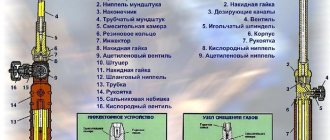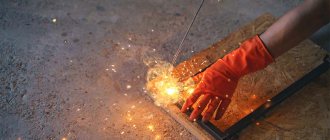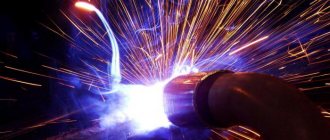Types, structural elements and their dimensions are established by GOST 16037-80 as amended. 1991
Symbols of welding methods
pipelines made of steel: manual arc welding P; arc welding in shielding gas: ZP - consumable electrode; ZN - non-consumable electrode; F - submerged arc welding; G - gas welding.
Structural elements and dimensions of welded joints of steel pipelines are given in table. 22.
Technical requirements and accepted designations.
1. When making tees and crosses from pipes, the types of welded joints established for branches with pipes must be used, and when welding tees, crosses and transitions with pipes or flanges - respectively, the types of welded joints of pipes with pipes or pipes with flanges.
2. Welding butt joints of parts of unequal thickness with a difference not exceeding the values indicated below in the table. 22a, must be produced in the same way as parts of the same thickness; the structural elements of the prepared edges and the dimensions of the weld should be selected according to their greater thickness.
To ensure a smooth transition from one part to another, an inclined position of the seam surface is allowed. If the difference in the thickness of the parts being welded exceeds the values indicated in the table. 22a, on a part that has a large thickness, a bevel should be made to the thickness of the thin part. In this case, the structural elements of the prepared edges and the dimensions of the weld should be selected based on their smaller thickness.
Where is it used?
A butt joint is used when metal thickening is excluded or not suitable , it provides a beautiful appearance without protruding edges. Butt joints are used in the aerospace and automotive industries. It is used to form a permanent connection between parts of various metal structures in the case when the surfaces of the parts lie in the same plane and are adjacent to each other at their ends .
Parts of various pipelines, shells of various containers, cylinders, tanks, sheet structures, channels, angles and other shaped profiles are butt welded.
Advantages and disadvantages
Advantages
Pipe welding is usually done using a butt joint
For butt connection
- less electrode metal is used,
- it is not difficult to control the process, the designs are reliable,
- The welding technique is simpler than the fillet weld technique,
- butt joints ensure the flatness of the surface of the structure,
- provide connections between parts of different thicknesses,
- It is possible to weld thick metal with a one-sided seam.
Flaws
Butt joint
- does not provide additional rigidity compared to overlap,
- Significant surface deformations may also occur after welding (especially when welding thin metal).
Designation of seams in the drawing
In the production of any structures, parts are joined in various ways. One method is welding. The resulting seam has certain properties that affect the performance characteristics of the entire product.
It is important to correctly designate the weld on the drawing so that the connection methods, joint shapes, geometric parameters, etc. are clear. A competent specialist can glean information from the drawing about the strength, tightness of the joint, and the time of work.
Arrows, letters, numbers and auxiliary icons are used to indicate metal connections.
Full joint markings include:
- auxiliary signs;
- reference to the standard;
- alphanumeric designation;
- indication of the type of welding;
- leg sizes;
- values of the length of the welded area or the diameter of the point;
- additional signs.
How is it different from overlap
Welded lap joints are the fusion of different elements of a part located in parallel, partially overlapping each other. Used when butt jointing is not possible. An overlap connection is not recommended if the structure is subject to vibration; the steel thickness should be no more than 10-12 mm.
With butt it is important to take into account the accuracy of assembly , while with overlap assembly is much simpler and there is no need to cut the edges.
The disadvantage of an overlap joint will be the greater consumption of base metal, since one part covers another, corrosion of the metal may occur from moisture penetration between the parts, and it will not be easy to identify defects. In butt welding there is no overlap (overlapping) of parts; different welding techniques are used when welding overlap joints is performed using a fillet weld . In lap joints there is no need to cut the edges; there are also a large number of types of butt joints according to GOST.
The principle of choosing a welding method and type of connection
About 150 types of welding are used to join parts. One thing they have in common is the designation of seams in welded joints. Any development involves carrying out calculations established by the technical specifications for it. To determine the method of fastening parts, designers perform calculations that determine the geometry of the joints and the thickness of the structures being welded.
Calculations allow you to determine the type of welding that should be used: manual using electrodes, arc with shielding gases, etc. In your work, you must be guided by the requirements of standards containing the necessary information.
Cutting edges for welding
butt joint without beveled edges
Important! If you weld without beveled edges and the metal thickness is more than 2 mm, you need to set a gap between the parts being welded!
The quality of the seam and the product depends on the choice of bevel of the edges. For each welding method, different edge preparations are selected.
For your information! Without cutting, the process will be much more economical, but cutting the edges is necessary for complete penetration in the cross-section, which makes the quality higher.
with V-shaped edges
with X-shaped bevel edges
with curved edges
The cutting can be done with a chisel, in this case the edges will not be even, an excellent option would be a grinder, a milling machine, the best option would be to use an edge cutter (beveler). also need to control the cleanliness of the bevels in order to get a high-quality seam without defects . For butt joints, all types of edge cutting are used depending on the thickness of the metal and the nature of the seam (one-sided or double-sided seam).
There is a designation for cutting edges: U-V-K-X-shaped. The X-shaped groove of the edges, compared to the V-shaped one, allows you to reduce the volume of deposited metal; the X-shaped groove requires one seam on each side, while the V-shaped one requires a one-sided seam. The shape of the edges depends on the welding method, the material being welded, and the thickness of the elements being welded. [ads-pc-3][ads-mob-3]
Seam options depending on the outer surface
What the mechanical and physical characteristics of the connecting joint will be depends on its shape. If the joints have convexities, then they are processed with a milling cutter or abrasive wheels.
In the table I show what convex joints are and how the welded joint is indicated in the drawing.
| Connection types | Joint | How is it portrayed? | Characteristics |
| Normal | _________ | Economical in the process of creation, stable under constant loads. | |
| Concave | Best used under dynamic loads, easy to perform. | ||
| Convex | They involve the use of consumables and are not economical. |
How to cook
Before starting welding, technological preparation is carried out. Parts should be marked, cut, surfaces should be cleaned of dirt and rust and dried if moisture is present.
The two parts to be welded must lie on a flat surface and have a gap of 2-3 mm between them; we ignite the electrode with a blow or “strike” like a match, and perform two tacks to avoid deformation of the joint being welded.
Video
The video below shows what welding can lead to if you don’t use tacks (what you need to know about tacks here).
with lining (removable or remaining)
You can move the electrode towards yourself, away from you, from right to left and from left to right. Depending on the thickness of the metal and the recommended spatial position of the electrode, the method of moving the electrode for better welding is selected, and the electrode is also held at an angle of 45 degrees during operation.
After completing the seam, the slag is removed and the surface is cleaned. To avoid burns, use linings, with them the work is more confident, you can increase the current and not cook on the other side of the seam (see photo on the left).
Welding in the down position
The parts are cleaned; for thin metal, edge cutting is not performed; the gap between the parts to be welded is 1-3 mm. The assembly is carried out, the tacks are installed (after the tacks are cleaned), then welding is carried out on the back side of the tacks.
The thickness of the roller should not exceed 9 mm and the height 1.5 mm. We carry out welding from left to right, perform circular oscillatory movements counterclockwise, also weld the second side, on the second side you can increase the current, after welding we clean the surfaces.
butt joint with flange (for thin metal)
During the welding process, the electrode makes 2-3 movements.
- The electrode is lowered down as it melts, ensuring a stable burning of the welding arc.
- The electrode is moved at a uniform speed, tilting it at an angle of 15-30 degrees from the vertical. In the other plane, the electrode is perpendicular to the joint surface.
- If it is necessary to obtain a weld of increased width, various oscillatory movements are used.
Types of welding seams
Types of welded joints.
First, ESKD is the Unified System of Design Documentation, or, to put it simply, a set of various standards according to which all modern technical drawings, including documentation for welding work, must be carried out.
This system contains several standards that interest us:
- GOST 2.312-72 entitled “Conventional images and designations of seams of welded joints”.
- GOST 5264-80 “Manual arc welding. Welded joints”, which comprehensively describes all possible types and designations of welds.
- GOST 14771-76 “Weld joints, welding in shielding gases.”
To understand the symbols of welding methods in engineering drawings, you need to understand their types. We suggest looking at an example of a weld designation in the drawing:
It looks bulky and intimidating. But we won’t be nervous and will slowly figure it out. There is a clear logic in this long abbreviation, let's start moving step by step. Let's break this monster down into nine parts:
Now these same components in squares:
- Square 1 – auxiliary signs to indicate: a closed line or an installation connection.
- Square 2 is the standard by which the symbols are given.
- Square 3 – designation by letter and number of the type of connection with its structural elements.
- Square 4 – welding method according to the standard.
- Square 5 – type and dimensions of structural elements according to the standard.
- Square 6 – characteristic in the form of the length of a continuous section.
- Square 7 – characteristics of the connection, auxiliary sign.
- Square 8 is an auxiliary sign for describing a connection or its elements.
Now let’s look at each element of our long abbreviation in detail.
In square No. 1 there is a circle - one of the additional characteristics, a symbol of a circular connection. An alternative symbol is a flag, indicating a mounting option instead of a circular one.
A special one-way arrow shows the suture line. Another specific feature of welding drawings is associated with this arrow. This single-faced arrow has a nice feature called a shelf. The shelf plays the role of a real shelf - all symbols can be located on the shelf if a visible connection is indicated.
Or under the shelf, if the seam is invisible and located on the reverse side, i.e. from the inside out. What is considered the front side and what is the back side? The front side of a one-way connection is always the one that is being worked on, it's simple. But in the double-sided version with asymmetrical edges, the front side will be the one where the main joint is welded. And if the edges are symmetrical front and back, any side can be used.
Here are the most popular auxiliary signs used in welding drawings:











